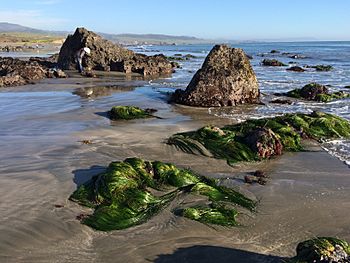Scouler's surfgrass facts for kids
Quick facts for kids Scouler's surfgrass |
|
|---|---|
 |
|
| Surf grass at low tide, with Laminaria setchllii kelp, at Montana de Oro State Park | |
| Scientific classification | |
| Genus: |
Phyllospadix
|
| Species: |
scouleri
|

Phyllospadix scouleri, also known as Scouler's surfgrass, is a special type of flowering plant. It lives in the ocean and belongs to the Zosteraceae family. You can find this plant along the coast of western North America. It grows from the Alaskan panhandle all the way down to Baja California.
This plant is bright green and has long, flat leaves. It often grows in big groups or "beds." These beds are uncovered when the tide is low and covered by water when the tide is high. Scouler's surfgrass attaches itself to rocks in the middle and lower parts of the intertidal zone. This is the area between high and low tide marks.
Contents
How Scouler's Surfgrass Lives
Scouler's surfgrass plants have separate male and female flowers. There are many more female plants than male ones. The flowers grow in spikes at the bottom of the leaves and do not have petals.
Reproduction and Life Cycle
The pollen from male plants spreads through water movement. This can happen underwater. However, most of the pollen transfer happens on the surface of the sea. This usually occurs when the tide is very low.
Young surfgrass plants, called seedlings, cannot grow directly on bare rocks. Instead, they start growing among algae, like red coralline algae. They attach themselves using small barbs. Their roots then weave among the algae as they grow bigger.
Surfgrass also sends out special underground stems called rhizomes. These rhizomes can spread out and help the plant grow into new areas. Once surfgrass is established, it can become the main plant in its habitat.
Who Lives in Surfgrass Beds?
Surfgrass beds are home to many different kinds of invertebrates. Invertebrates are animals without backbones. This includes animals like snails, limpets, and crustaceans. Sometimes, other types of algae might even grow on the stems and leaves of the surfgrass itself.
Uses by People
Long ago, Native American tribes living along the Southern California Coast used sea grass. They used it to make cordage, which is like rope or string. They also wove it into other objects. Some examples of these woven items have been found on San Miguel Island. These items are very old, dating back about 10,000 to 8,600 years ago.

